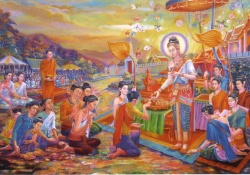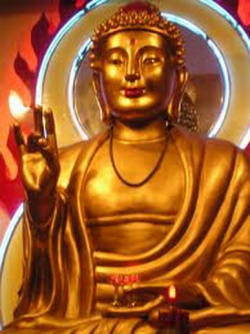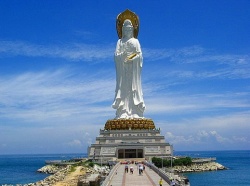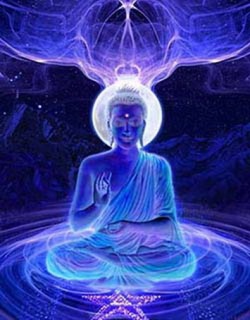Theravada - Mahayana Buddhism by Ven. Dr. W. Rahula
Let us discuss a question often asked by many people: What is the difference between Mahayana and Theravada Buddhism?
To see things in their proper perspective, let us turn to the history of Buddhism and trace the emergence and development of Mahayana and Theravada Buddhism.
The Buddha was born in the 6th Century B.C.
After attaining Enlightenment at the age of 35 until his Mahaparinibbana at the age of 80, he spent his life preaching and teaching.
He was certainly one of the most energetic man who ever lived: for forty-five years he taught and preached day and night, sleeping for only about 2 hours a day.
The Buddha spoke to all kinds of people: kings and princes, Brahmins, farmers, beggars, learned men and ordinary people.
His teachings were tailored to the experiences, levels of understanding and mental capacity of his audience.
What he taught was called Buddha Vacana, i.e. word of the Buddha. There was nothing called Theravada or Mahayana at that time.
After establishing the Order of monks and nuns, the Buddha laid down certain disciplinary rules called the Vinaya for the guidance of the Order.
The rest of his teachings were called the Dhamma which included his discourses, sermons to monks, nuns and lay people.
The First Council
Three months after the Buddha's Mahaparinibbana, his immediate disciples convened a council at Rajagaha.
Maha Kassapa, the most respected and elderly monk, presided at the Council. Two very important personalities who specialised in the two different areas - the Dhamma and the Vinaya - were present.
One was Ananda, the closest constant companion and disciple of the Buddha for 25 years.
Endowed with a remarkable memory, Ananda was able to recite what was spoken by the Buddha.
The other personality was Upali who remembered all the Vinaya rules.
Only these two sections - the Dhamma and the Vinaya - were recited at the First Council.
Though there were no differences of opinion on the Dhamma (no mention of the Abhidhamma) there was some discussion about the Vinaya rules.
Before the Buddha's Parinibbana, he had told Ananda that if the Sangha wished to amend or modify some minor rules, they could do so.
But on that occasion Ananda was so overpowered with grief because the Buddha was about to die that it did not occur to him to ask the Master what the minor rules were.
As the members of the Council were unable to agree as to what constituted the minor rules,
Maha Kassapa finally ruled that no disciplinary rule laid down by the Buddha should be changed, and no new ones should be introduced. No intrinsic reason was given.
Maha Kassapa did say one thing, however: "If we changed the rules, people will say that Ven. Gotama's disciples changed the rules even before his funeral fire has ceased burning."
At the Council, the Dhamma was divided into various parts and each part was assigned to an Elder and his pupils to commit to memory.
The Dhamma was then passed on from teacher to pupil orally.
The Dhamma was recited daily by groups of people who often cross check with each other to ensure that no omissions or additions were made.
Historians agree that the oral tradition is more reliable than a report written by one person from his memory several years after the event.
The Second Council
One hundred years later, the Second Council was held to discuss some Vinaya rules.
There was no need to change the rules three months after the Parinibbana of the Buddha because little or no political, economic or social changes took place during that short interval.
But 100 years later, some monks saw the need to change certain minor rules.
The orthodox monks said that nothing should be changed while the others insisted on modifying some rules, Finally, a group of monks left the Council and formed the Mahasanghika - the Great Community.
Even though it was called the Mahasanghika, it was not known as Mahayana, And in the Second Council, only matters pertaining to the Vinaya were discussed and no controversy about the Dhamma is reported,
The Third Council
In the 3rd Century B.C. during the time of Emperor Asoka, the Third Council was held to discuss the differences of opinion among the bhikkhus of different sects.
At this Council the differences were not confined to the Vinaya but were also connected with the Dhamma.
At the end of this Council, the President of the Council, Moggaliputta Tissa, compiled a book called the Kathavatthu refuting the heretical, false views and theories held by some sects.
The teaching approved and accepted by this Council was known as Theravada.
The Abhidhamma Pitaka was included at this Council.
After the Third Council, Asoka's son, Ven. Mahinda, brought the Tripitaka to Sri Lanka, along with the commentaries that were recited at the Third Council.
The texts brought to Sri Lanka were preserved until today without losing a page.
The texts were written in Pali which was based on the Magadhi language spoken by the Buddha.
There was nothing known as Mahayana at that time.
Coming of Mahayana
Between the 1st Century B.C. to the 1st Century A.D., the two terms Mahayana and Hinayana appeared in the Saddharma Pundarika Sutra or the Sutra of the Lotus of the Good Law.
About the 2nd Century A.D. Mahayana became clearly defined. Nagarjuna developed the Mahayana philosophy of Sunyata and proved that everything is Void in a small text called Madhyamika-karika.
About the 4th Century, there were Asanga and Vasubandhu who wrote enormous amount of works on Mahayana.
After the 1st Century AD., the Mahayanists took a definite stand and only then the terms of Mahayana and Hinayana were introduced.
We must not confuse Hinayana with Theravada because the terms are not synonymous.
Theravada Buddhism went to Sri Lanka during the 3rd Century B.C. when there was no Mahayana at all.
Hinayana sects developed in India and had an existence independent from the form of Buddhism existing in Sri Lanka.
Today there is no Hinayana sect in existence anywhere in the world.
Therefore, in 1950 the World Fellowship of Buddhists inaugurated in Colombo unanimously decided that the term Hinayana should be dropped when referring to Buddhism existing today in Sri Lanka, Thailand, Burma, Cambodia, Laos, etc.
This is the brief history of Theravada, Mahayana and Hinayana.
Mahayana and Theravada
Now, what is the difference between Mahayana and Theravada?
I have studied Mahayana for many years and the more I study it, the more I find there is hardly any difference between Theravada and Mahayana with regard to the fundamental teachings.
- Both accept Sakyamuni Buddha as the Teacher.
- The Four Noble Truths are exactly the same in both schools.
- The Eightfold Path is exactly the same in both schools.
- The Paticca-samuppada or the Dependent Origination is the same in both schools.
- Both rejected the idea of a supreme being who created and governed this world.
- Both accept Anicca, Dukkha, Anatta and Sila, Samadhi, Panna without any difference.
These are the most important teachings of the Buddha and they are all accepted by both schools without question.
There are also some points where they differ.
An obvious one is the Bodhisattva ideal.
Many people say that Mahayana is for the Bodhisattvahood which leads to Buddhahood while Theravada is for Arahantship.
I must point out that the Buddha was also an Arahant.
Pacceka Buddha is also an Arahant.
A disciple can also be an Arahant.
The Mahayana texts never use the term Arahant-yana, Arahant Vehicle.
They used three terms: Bodhisattvayana, Prateka-Buddhayana, and Sravakayana. In the Theravada tradition these three are called Bodhis.
Some people imagine that Theravada is selfish because it teaches that people should seek their own salvation.
But how can a selfish person gain Enlightenment?
Both schools accept the three Yanas or Bodhis but consider the Bodhisattva ideal as the highest.
The Mahayana has created many mystical Bodhisattvas while the Theravada considers a Bodhisattva as a man amongst us who devotes his entire life for the attainment of perfection, ultimately becoming a fully Enlightened Buddha for the welfare of the world, for the happiness of the world.
Three Types of Buddhahood
There are three types of Buddhahood: the Samma Sambuddha who gains full Enlightenment by his own effort, the Pacceka Buddha who has lesser qualities than the Samma Sambuddha, and the Savaka Buddha who is an Arahant disciple.
The attainment of Nibbana between the three types of Buddhahood is exactly the same.
The only difference is that the Samma Sambuddha has many more qualities and capacities than the other two.
Some people think that Voidness or Sunyata discussed by Nagarjuna is purely a Mahayana teaching.
It is based on the idea of Anatta or non-self, on the Paticcasamuppada or the Dependent Origination, found in the original Theravada Pali texts.
Once Ananda asked the Buddha, "People say the word Sunya. What is Sunya?"
The Buddha replied, "Ananda, there is no self, nor anything pertaining to self in this world.
Therefore, the world is empty." This idea was taken by Nagarjuna when he wrote his remarkable book, "Madhyamika Karika".
Besides the idea of Sunyata is the concept of the store-consciousness in Mahayana Buddhism which has its seed in the Theravada texts.
The Mahayanists have developed it into a deep psychology and philosophy.




